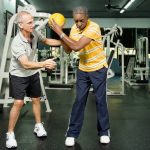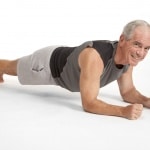
June 2020
Is There An Exercise Routine Older Adults Can and Will Do?
As we age, we lose muscle and bone mass. We don’t manage glucose levels as well. These predispose the elderly to reduced function and higher risk of falls and fractures which could seriously impair both quality and quantity of life. Encouraging the older population to be more active is challenging on many fronts, to say the least. We have written on this topic here, here, here and here, so this is worthy of deeper consideration by the research community and you.
A pilot study wanted to see what the feasibility and compliance with a 3-month exercise program was. They also wanted to see if a CAT scan could accurately determine muscle growth differences and a jumping mechanograph could detect changes in function.
Ninety-four adults over 70 years old were assigned to be in a walking group (WALK) or a walking plus balance and strength group (WALK+EX.) Compliance was excellent with 90% of the total subjects completing the study. Both groups also attended weekly nutrition education programs, with 86% compliance.
Results showed that 67% claimed to have increased overall activity levels and 82% said they felt better overall. Both groups lost body fat (avg. loss >1%), reduced waist circumference (avg. 2 cm in WALK, 1 cm in WALK+EX); only the WALK+EX group increased leg lean mass. Muscle density correlated with gait velocity, chair-rise power and chair-rise time pre- and post-intervention but only the WALK group showed a decrease in intramuscular fat and slight increase in muscle density. Both groups improved Timed Get-Up-Go and chair-rising tests, with no differences in balance. The WALK+EX had greater improvements in power, for standing and jumping.
The overall conclusion is that older adults can and will do a modest, properly-designed walking and strength and balance routine 3-5 days a week if sufficient support and guidance are provided.
MSSE Feb. 2020
Walk Breaks from Sitting Manage Blood Sugar
Sitting kills. Sedentary science has confirmed the multitude of downsides from excessive sitting, including higher rates of obesity and overweight, heart disease, blood sugar control, diabetes, back and neck pain, to name a few. Several studies have looked at the metabolic effects of various lengths and types of vertical behaviors one can do during long bouts of sitting.
A study from China aimed to determine “the effects of interrupting prolonged sitting with varying intermittent walking bouts of varying frequencies and durations on glycemic metabolism in sedentary adults.”
All subjects were between 20 and 35 yrs old, not obese, inactive (not meeting activity guidelines for moderate (150 mins/wk) or vigorous (75 mins/wk) activity), and sedentary for more than 8 hrs/day. Each participant did each of four 26-hour protocols in a metabolic chamber with blood sugar determined continuously: sit for 8 hours (SIT); 3-min of treadmill walking every 30 minutes during the 9 hours (WALK3); 5-min bouts every 45 minutes (WALK5); and 8-min bouts every 60 minutes (WALK8). In addition to the study phase there was an 8-hr sleep phase and a post-intervention phase with standardized meals also provided.
The authors found that each workload reduced the 26-hour mean glucose concentration compared to sitting the whole time. There was no statistical difference between the 3 WALK durations and neither conferred any lasting effects into the evening and sleep periods.
The bottom line is don’t spend so much time sitting.
MSSE Apr. 2020
Tid Bits
Hi-fat, hi-sugar processed foods don’t really satisfy; they may make you eat more and more frequently throughout the day. A study of mice given such delectables all day long, compared to a group that ate what they’d eat in the wild, ate at night and between meals until they became obese. Other mouse studies found that extra calories consumed outside normal times are more readily stored as fat. Seems we humans aren’t too different, huh? Duke Health News Mar. 2020
Are current methods of determining how hard one should exercise to get optimal benefits really useful enough to elicit the desired gains? A study compared 3 traditional methods of prescribing exercise intensity – % maximal aerobic capacity, % peak work rate and % maximal heart rate – to actual values determined on a cycle ergometer test. They found that there is so much variability between subjects that “defining each exercise-intensity domain, the fixed-percentage approach cannot guarantee an accurate” individualized exercise prescription. In other words, work hard but not severely so. MSSE Feb. 2020
Studies have shown that group visits of diabetes patients can help lower hemoglobin A1c, a measure of long-term blood sugar management. Some Duke researchers tested if these group meetings would help with weight management. One group attended nurse-led discussions on managing hypoglycemia, preventing complications and foot care; the other did weight management (WM) sessions to learn how to eat lower-carb. Doctors met individually to regulate and prescribe medications. While the WM group reduced medications, both groups attained similar, but still high, A1c levels. The WM group also lost more weight and had fewer hypoglycemia events. So maybe priority should be given to weight management by carb reduction vs nurse-led educational sessions. Duke Health News Mar. 2020
















